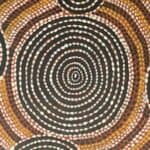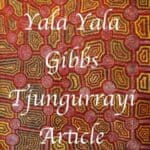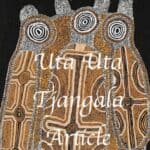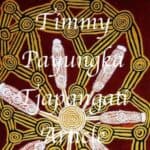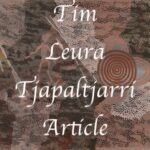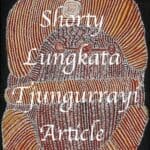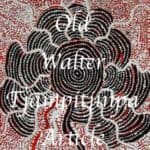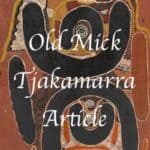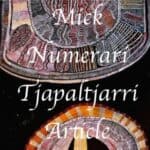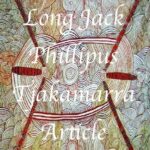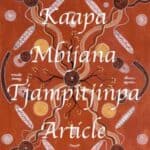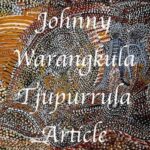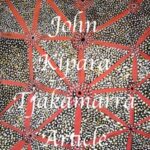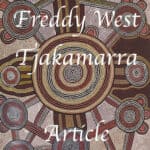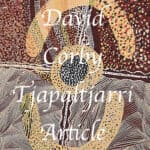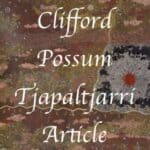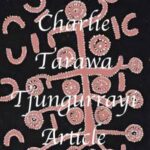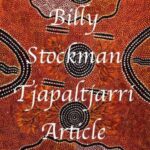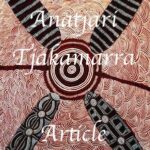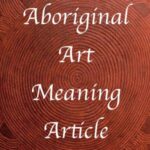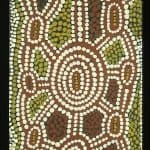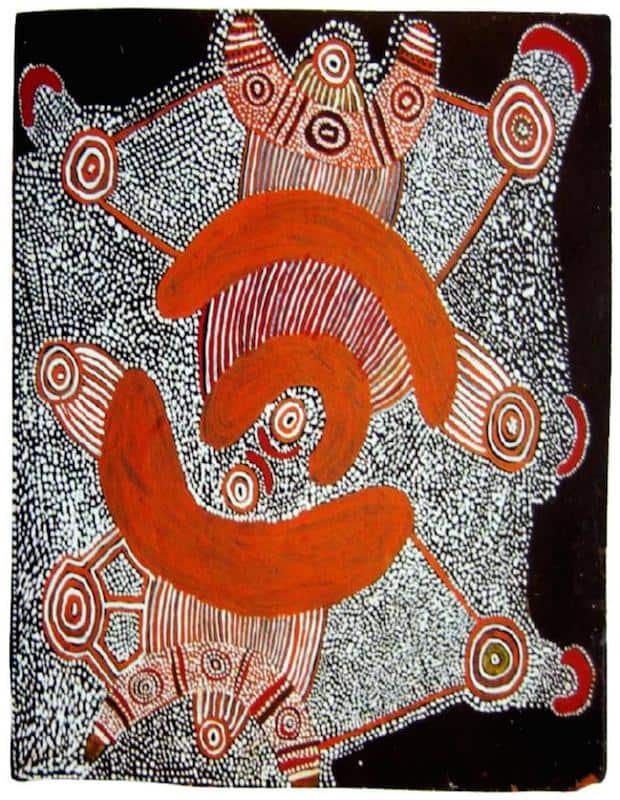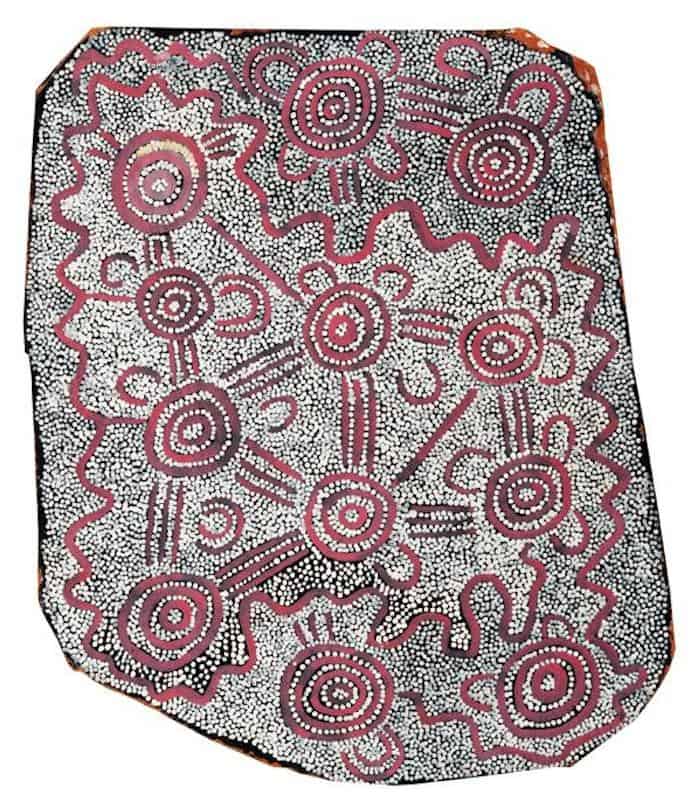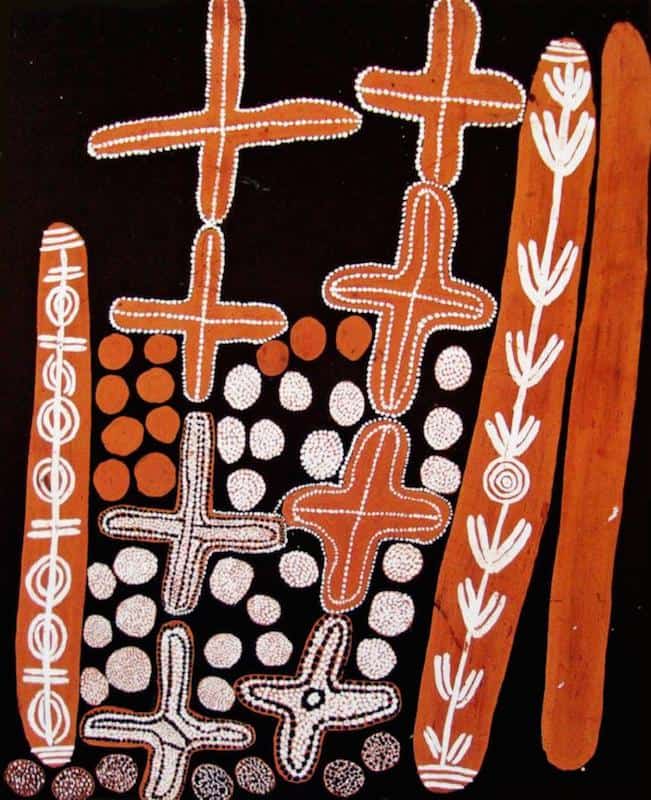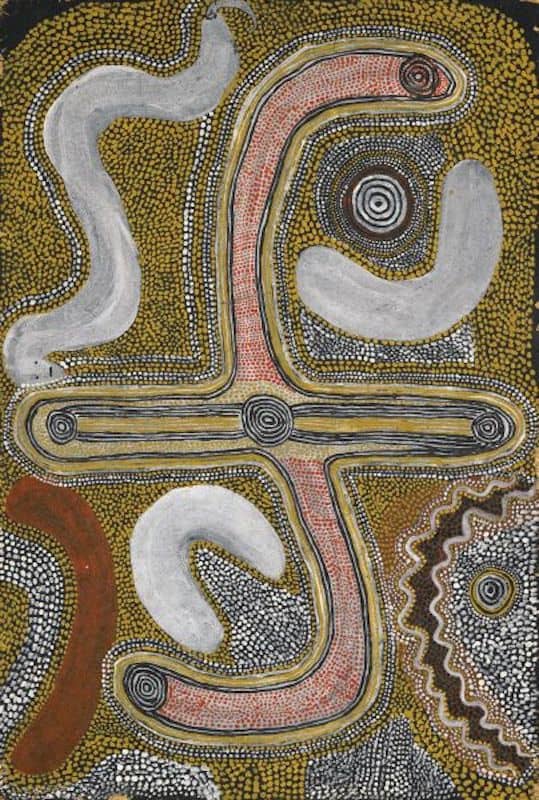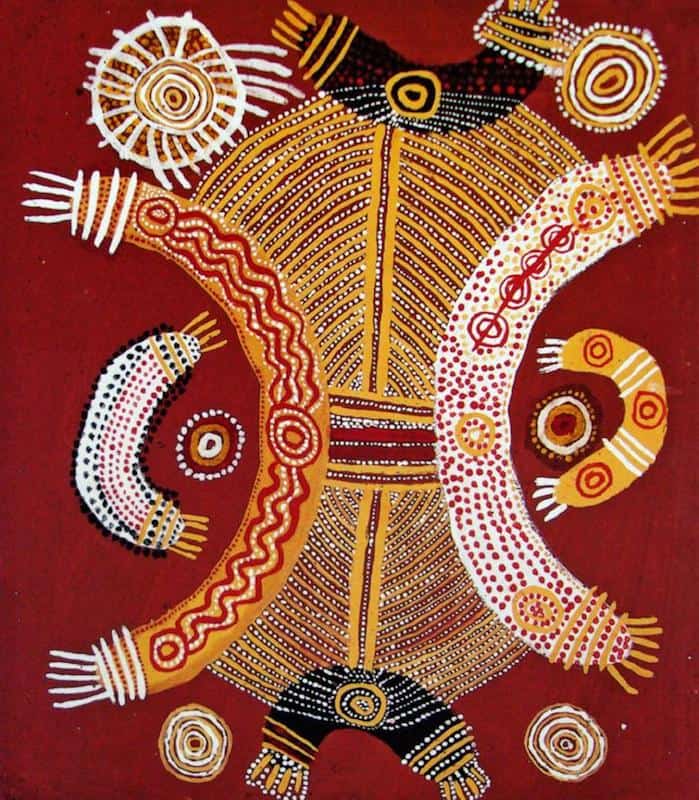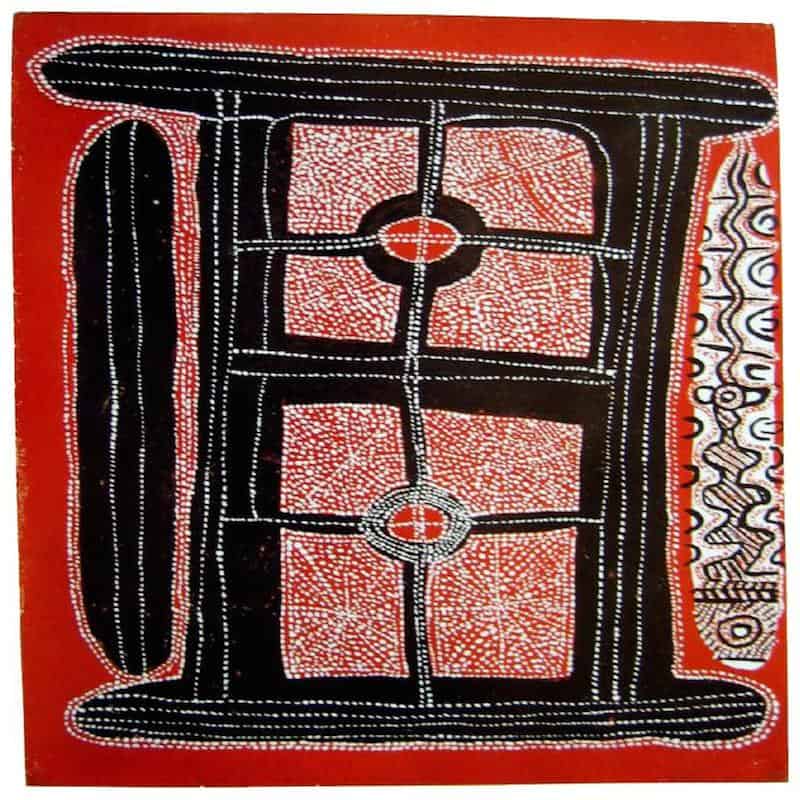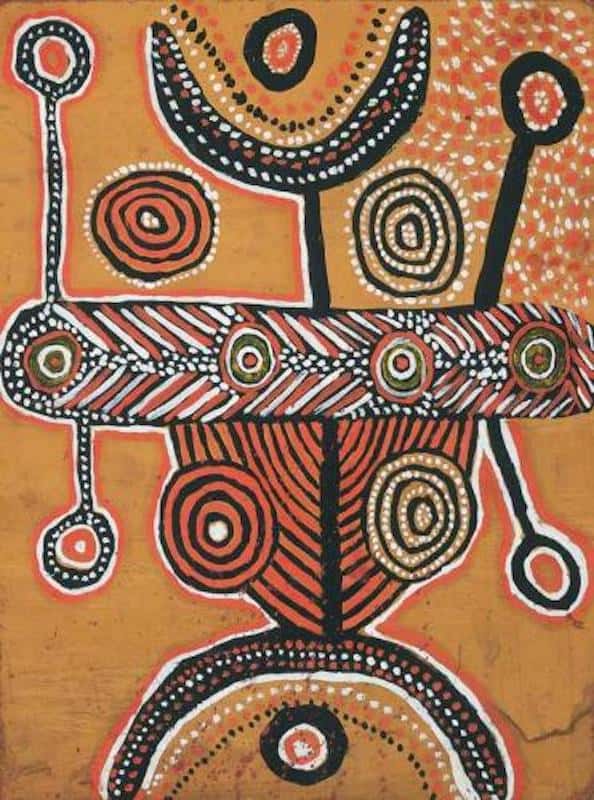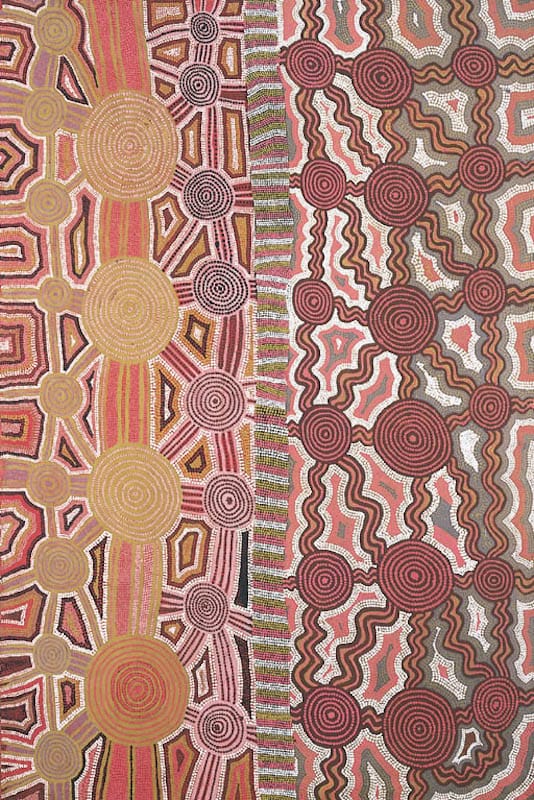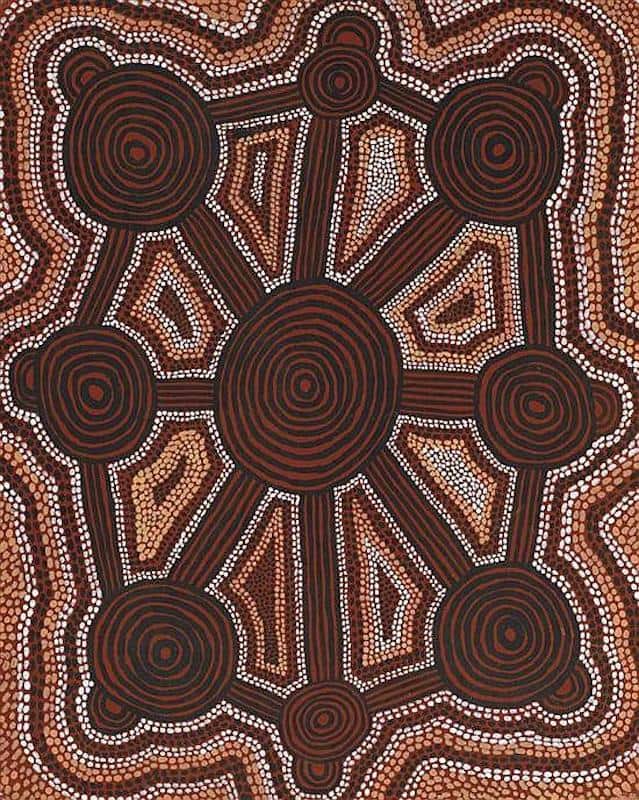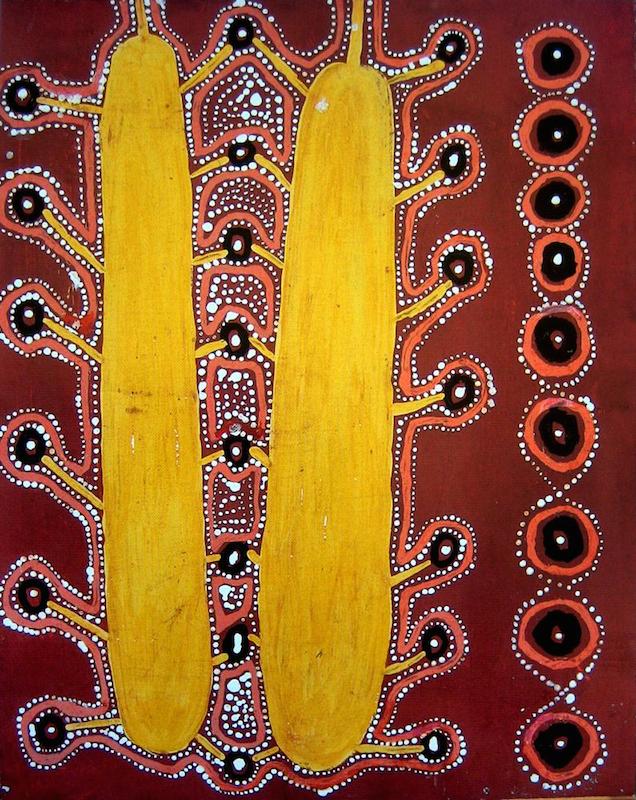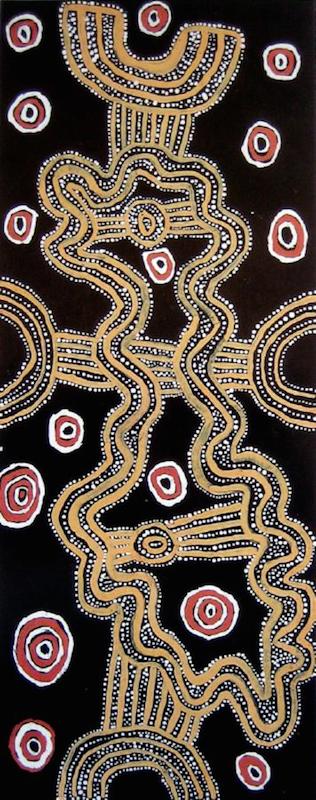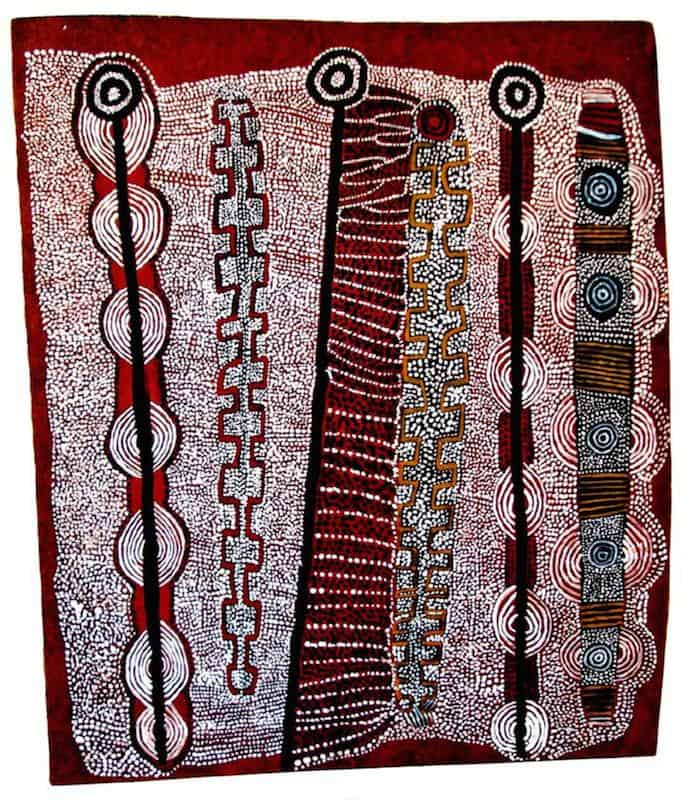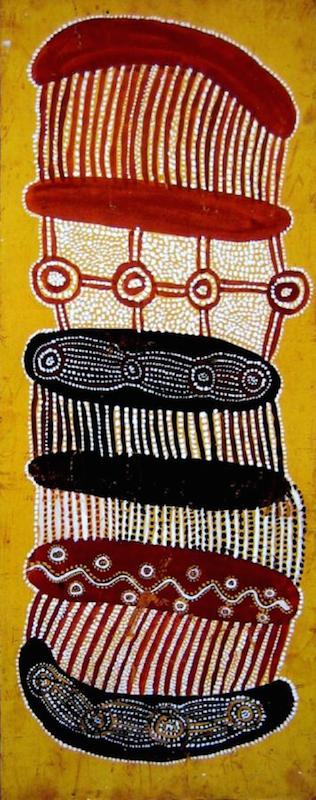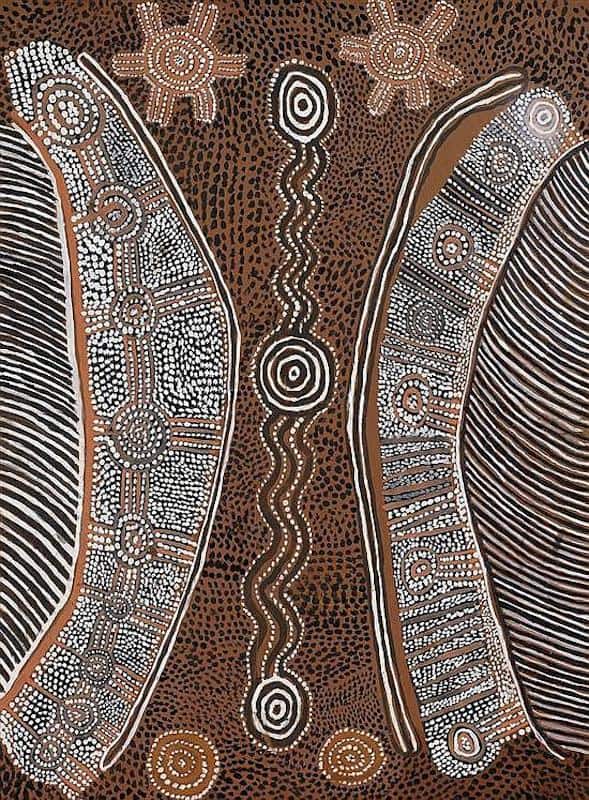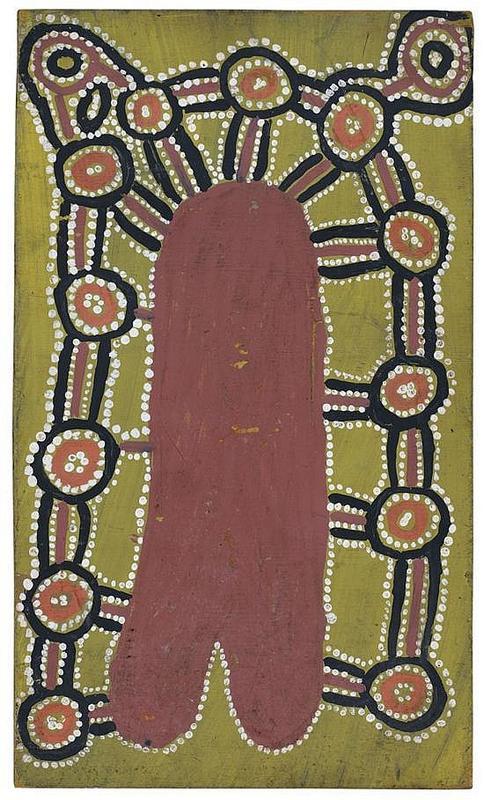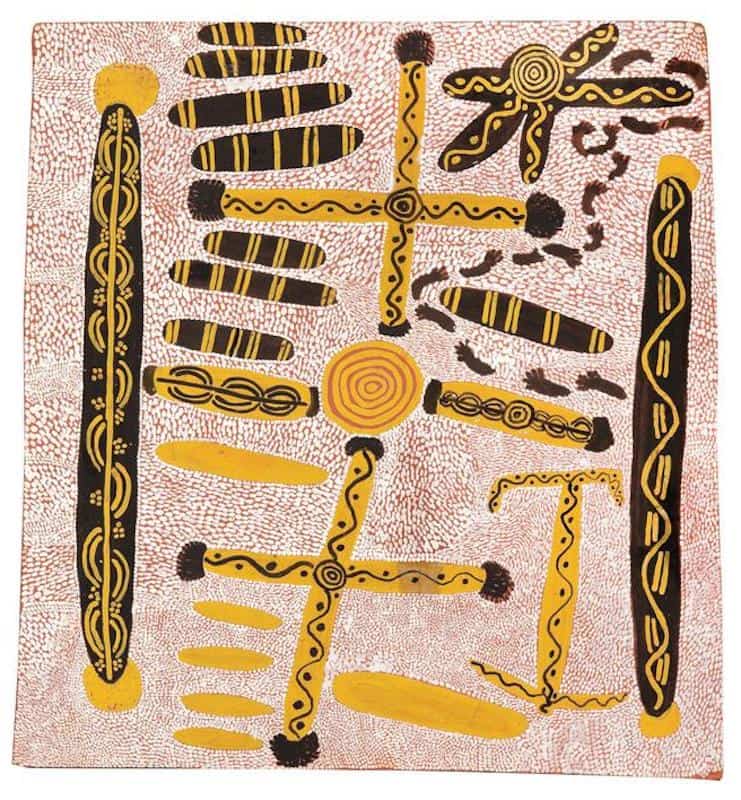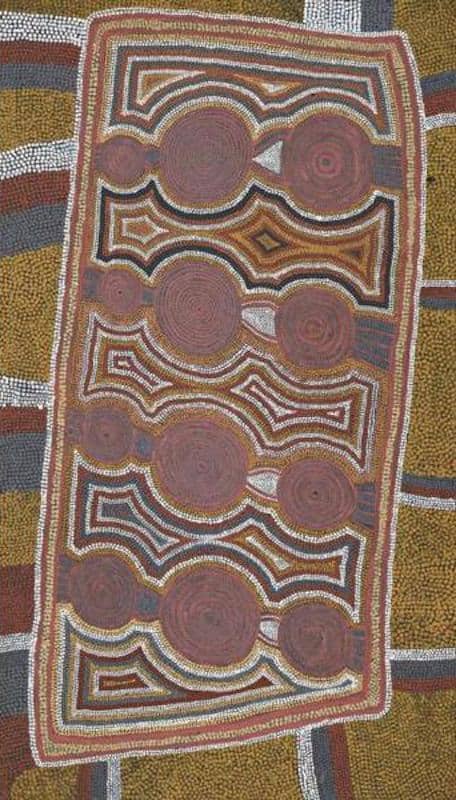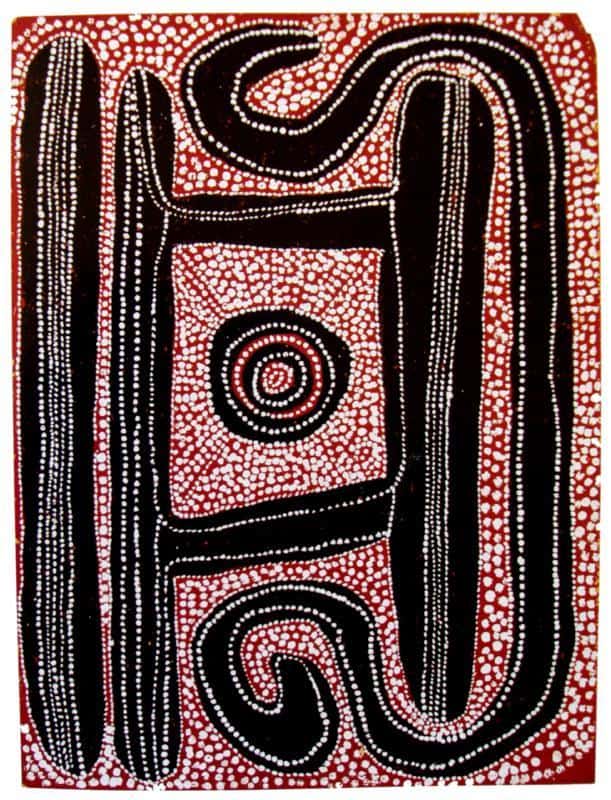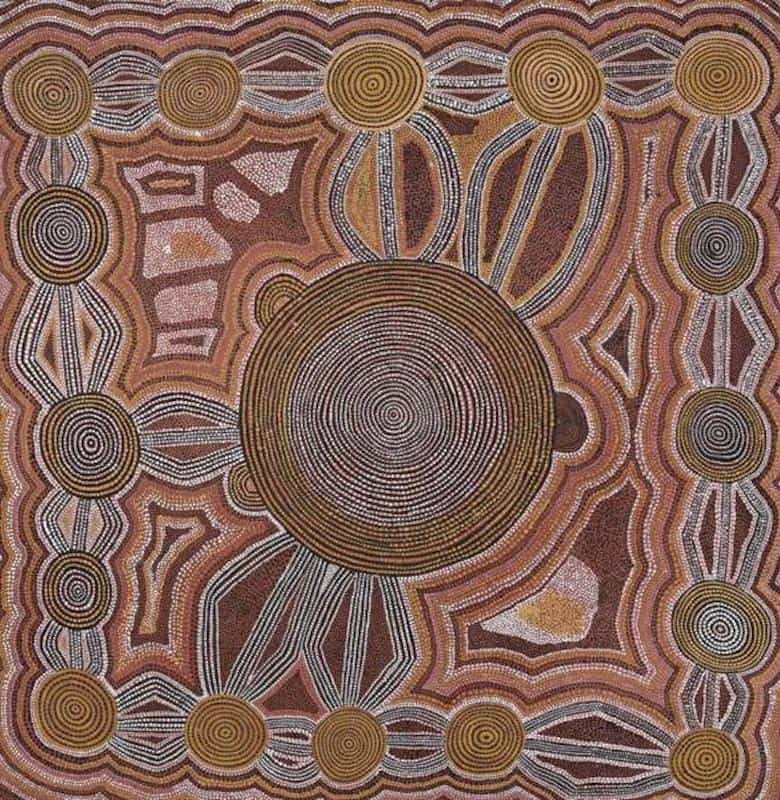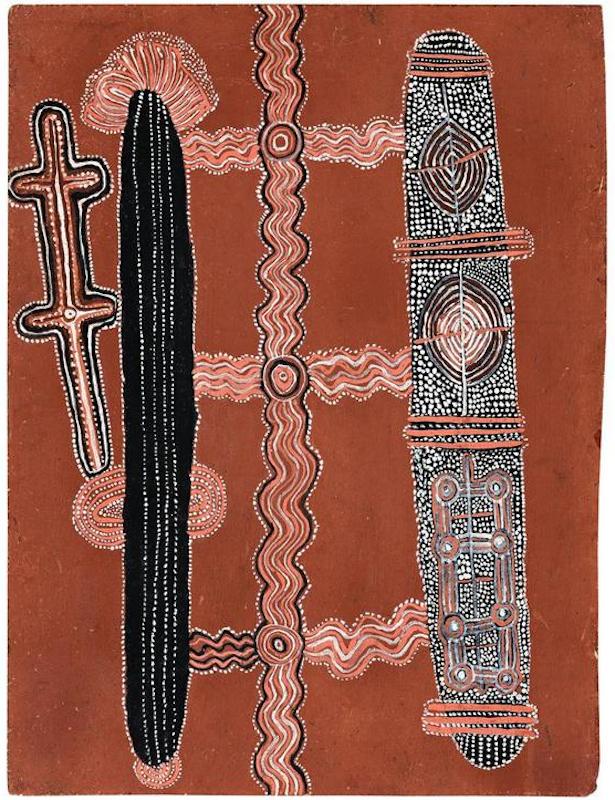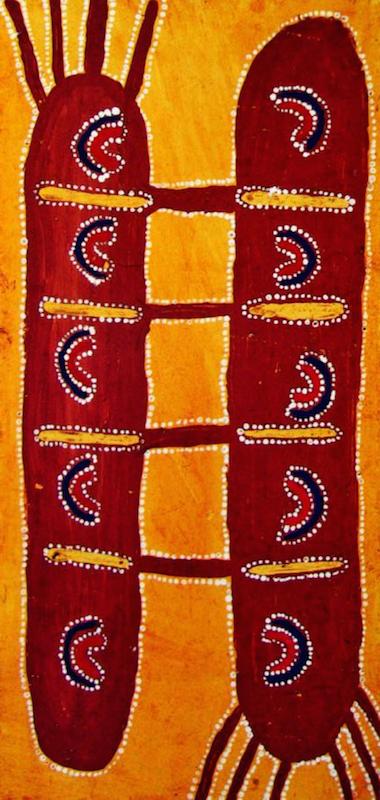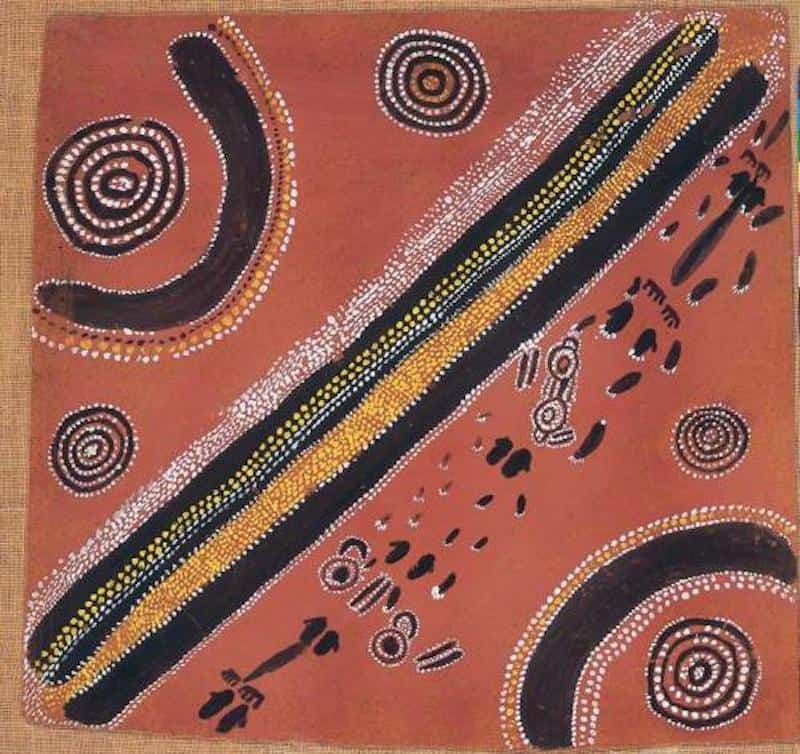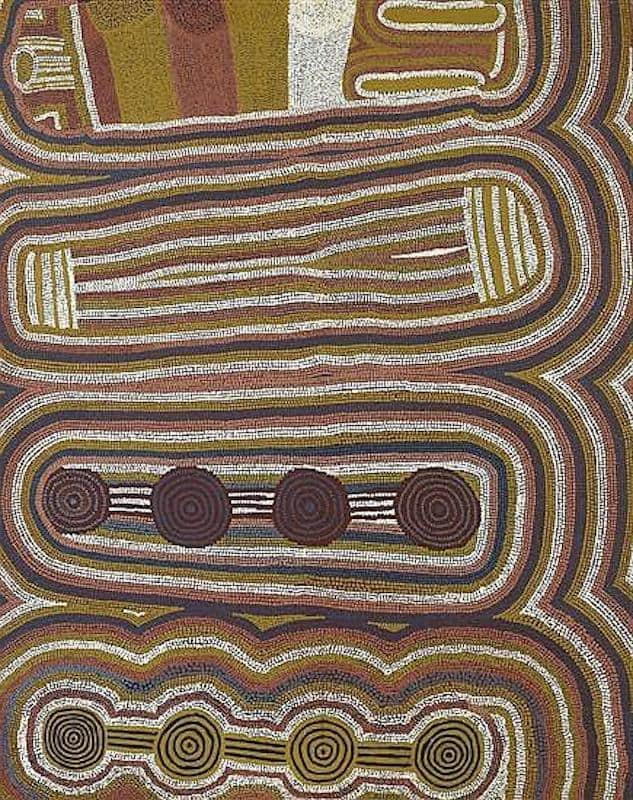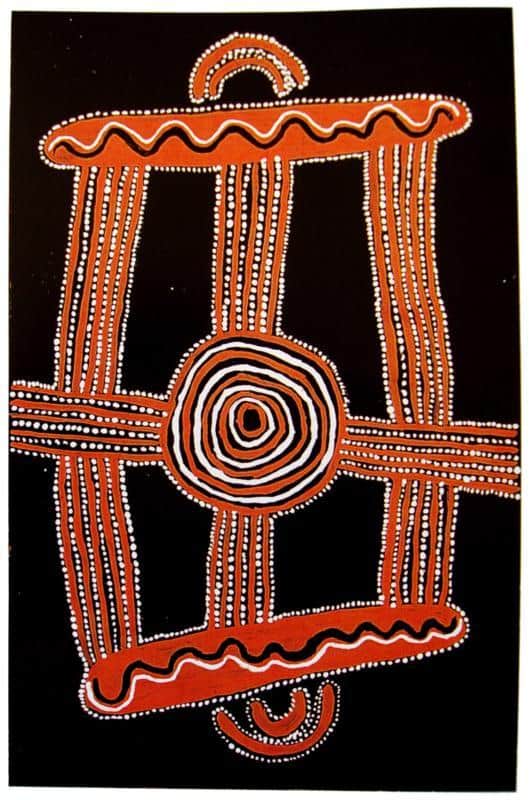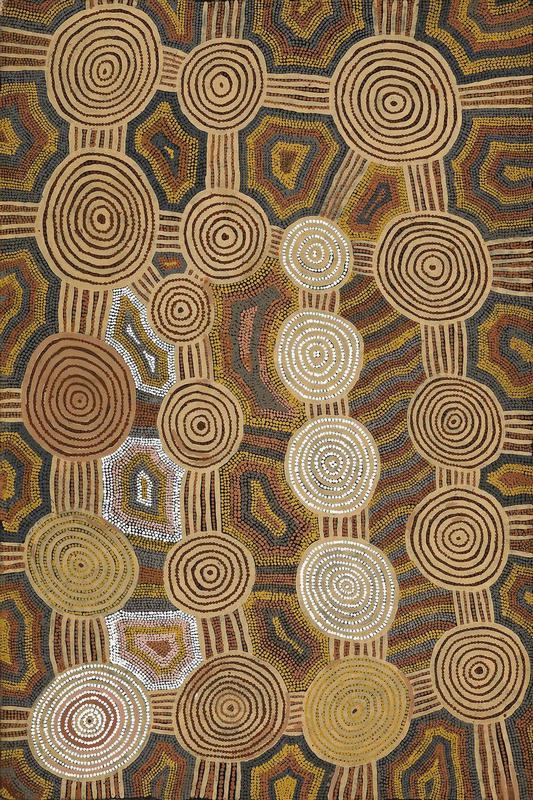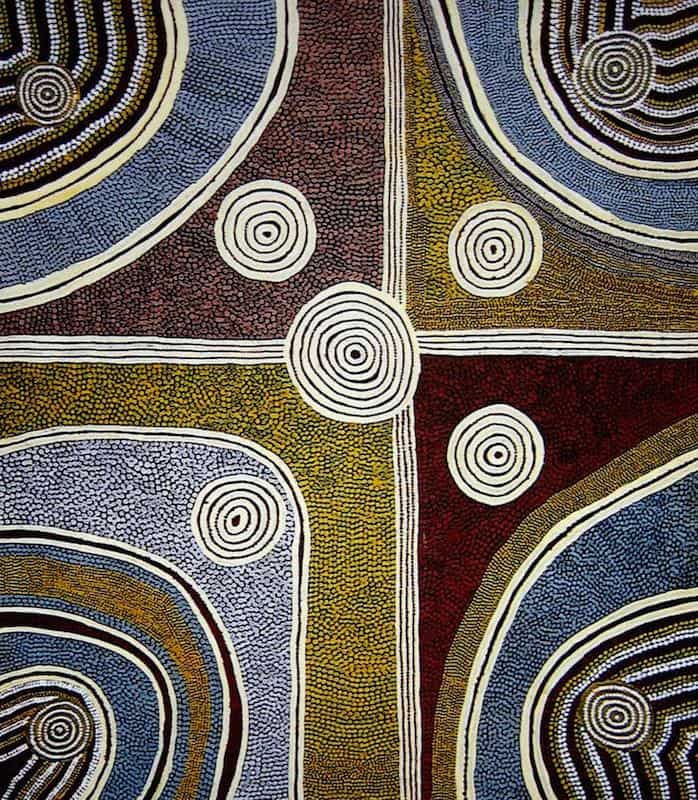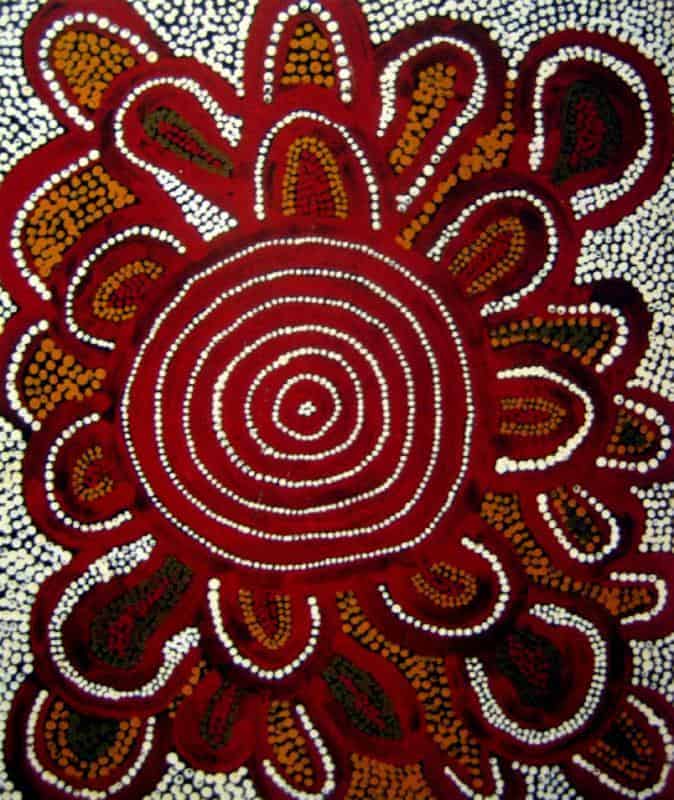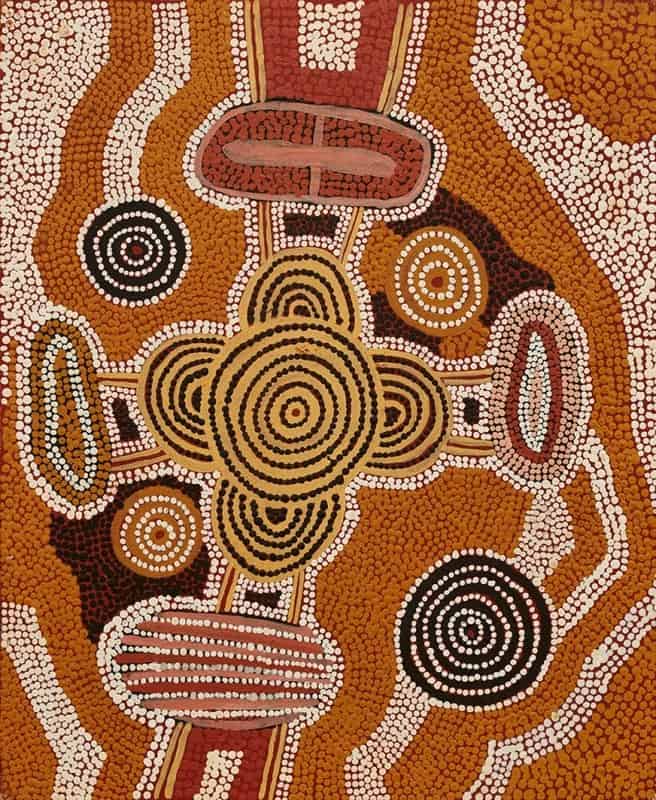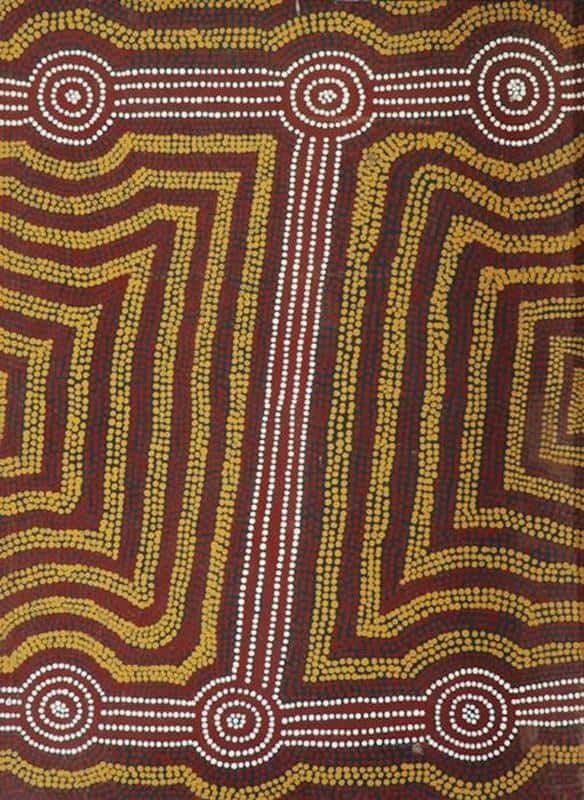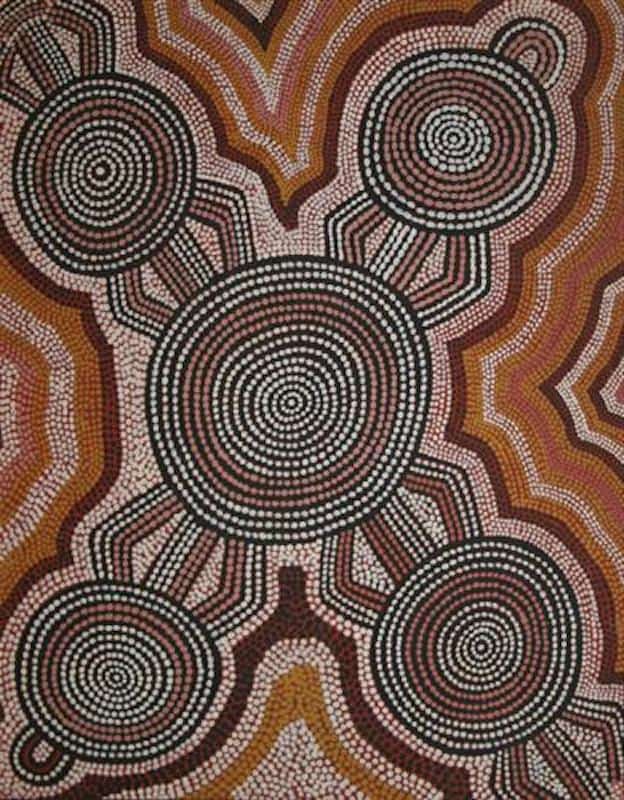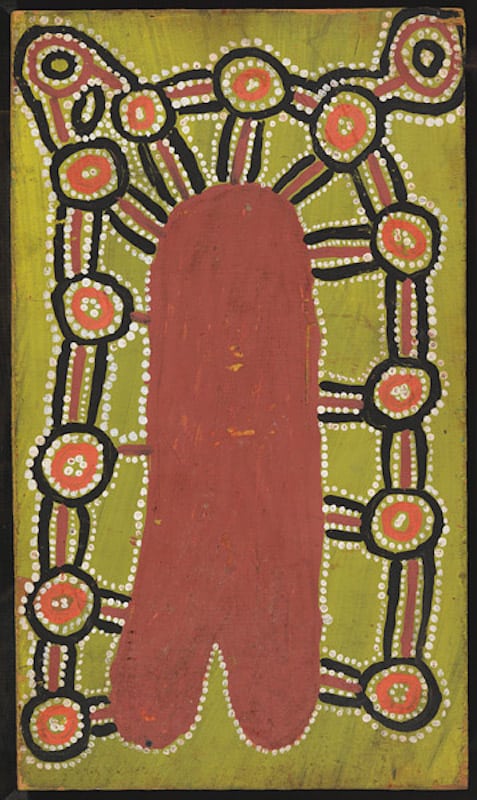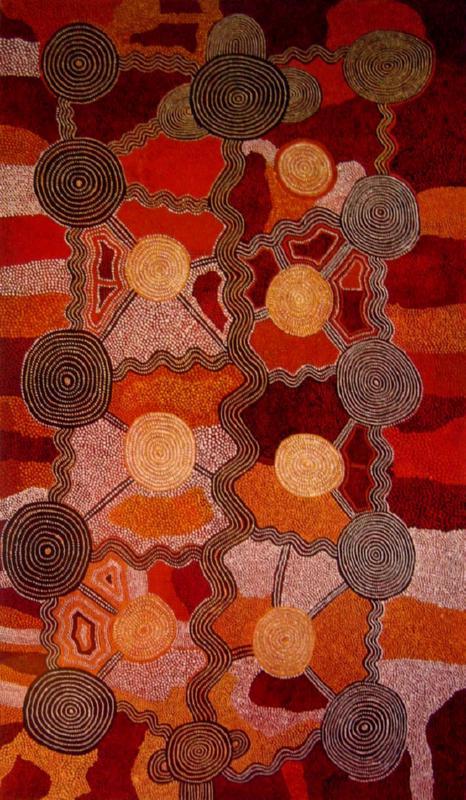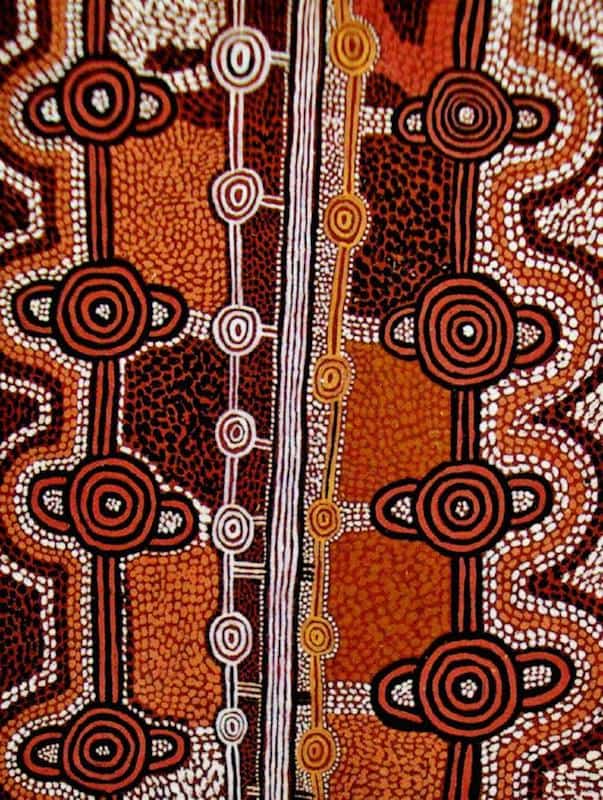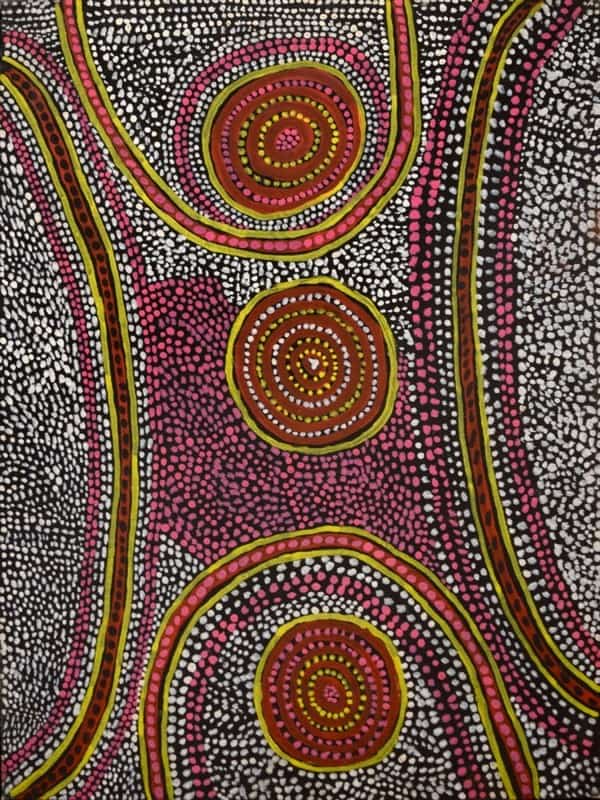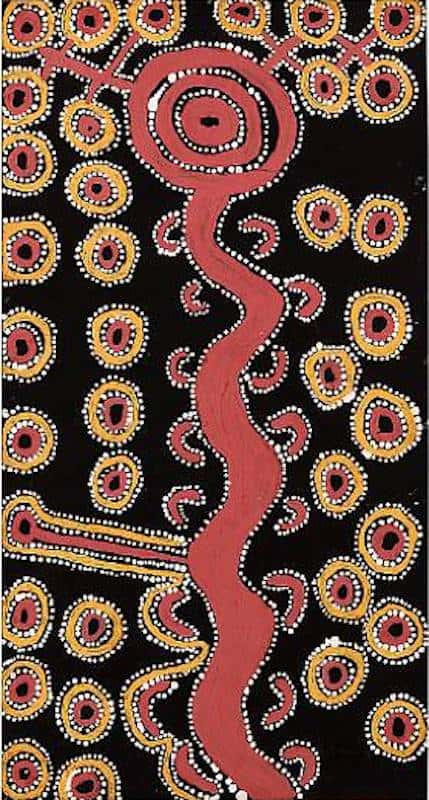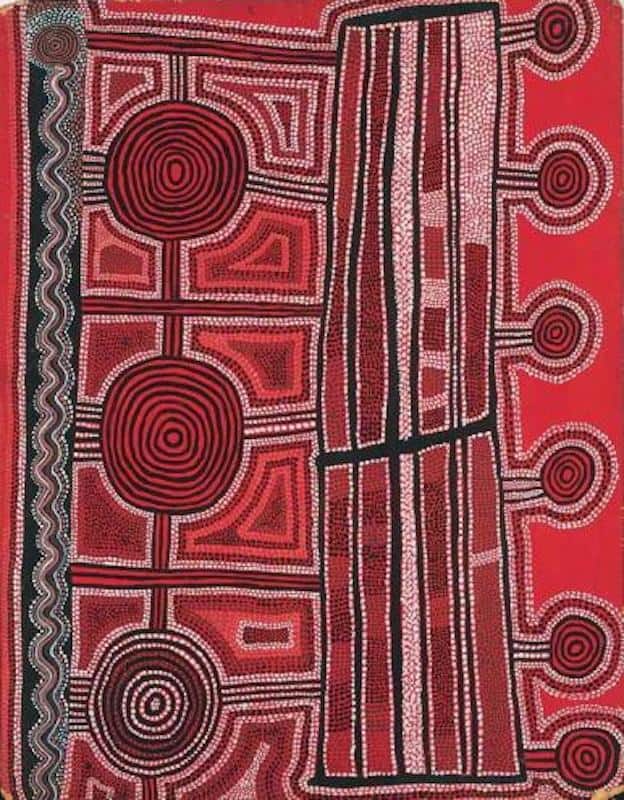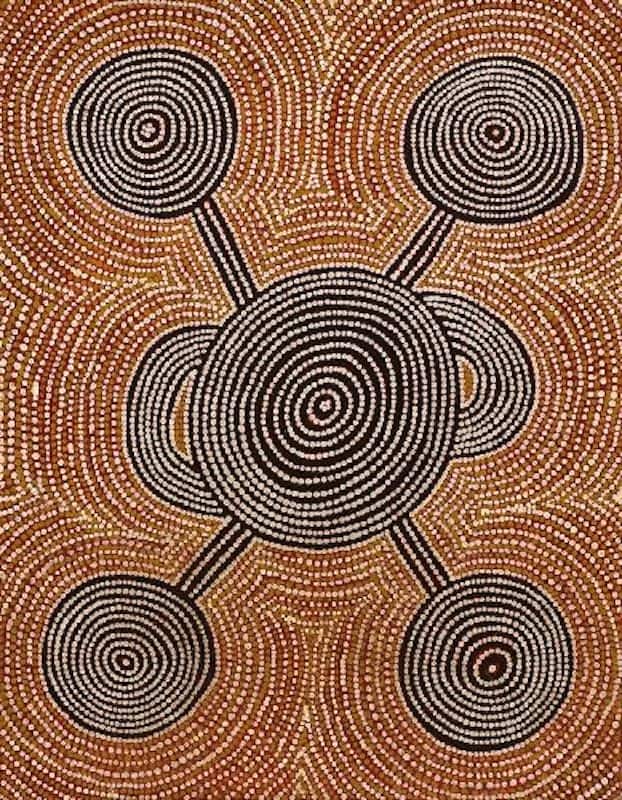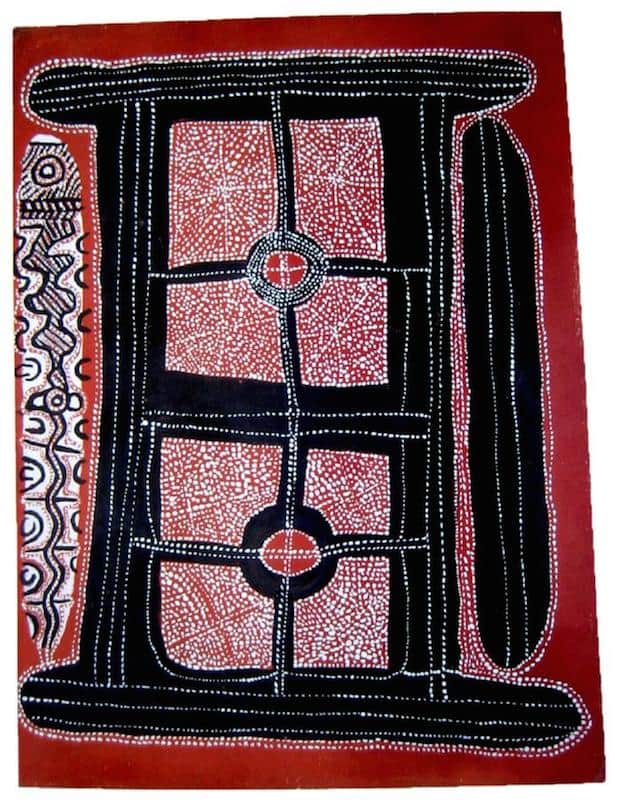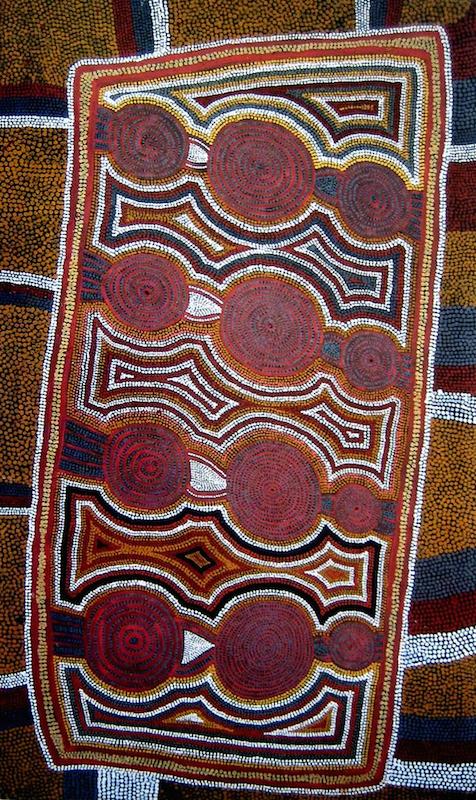Uta Uta Tjangala : Aboriginal Paintings
Uta Uta Tjangala was one of the founding members of the Western desert Aboriginal art movement. In the early part of his career he painted on Composition board. Many of his Early paintings being less than 50 cm x 50 cm. Many of his early works are ritual in nature. They contain secret imagery meant only for the eyes of initiated men.
The aim of this article is to assist readers in identifying if their Aboriginal painting is by Uta Uta Tjangala . It compares examples of his work.
If you have a Uta Uta Tjangala Aboriginal painting to sell please contact me. If you want to know what your Uta Uta Tjangala painting is worth please feel free to send me a Jpeg. I would love to see it.
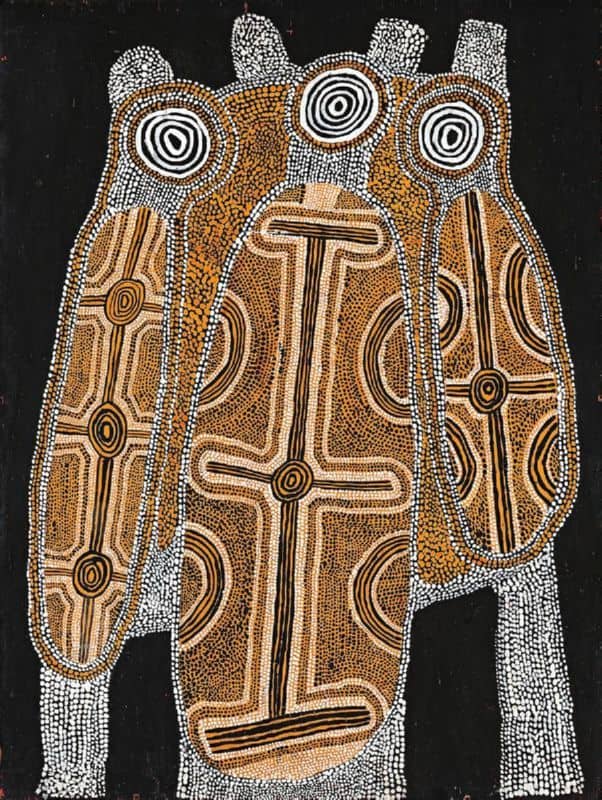
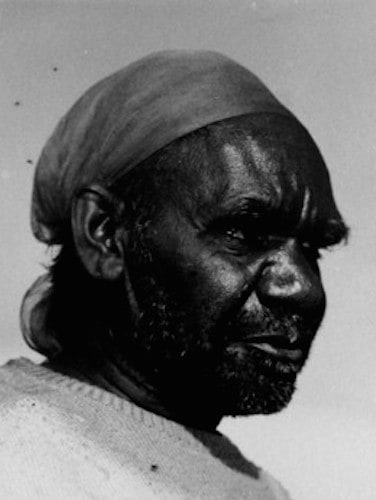
Uta Uta Tjangala Early Life
Uta Uta Tjangala was born around 1926 in Western Australia in Drovers Hills. He made an epic journey to Haasts Bluff with his family during the severe drought of late 1950’s in the company of Charlie Tarawa.
Two years later he returning to his homelands.
In 1957 Uta Uta moved back to Haasts Bluff with Timmy Payungka and his wife and child .
He settled in Papunya in the late 60’s and became the primary school’s gardener along with Antajari and Long Jack.
Early Painting
In 1971 Geoff Bardon a local school teacher encouraged aboriginal people to paint and record their traditional stories.
When supplying paints to Uta Uta and his friends, Bardon suggested the men use their existing cultural symbols and depict their Dreamings and links to the land.
Uta Uta’s painting career and reputation began at this time. He was a founding member of a men’s painting group. Being a senior Pintupi tribesmen he and Charlie Tarawa soon inspired other Pintupi tribesmen like Shorty Lungkata and Yala Yala to join them.
The Pintupi men painted under a bough shelter behind the camp. They painted using traditional sacred images while chanting the song cycles that told the stories.
Uta Uta’s earliest works generally featured major story elements with only the barest dotted in-fill within the iconography and small sections of the background. Paintings with clean unadorned background are more popular with collectors. They feel stronger and more powerful.
The rather crude dotting and line work of these early paintings on board gives them an energy and power that is less apparent in his later more technically proficient works.
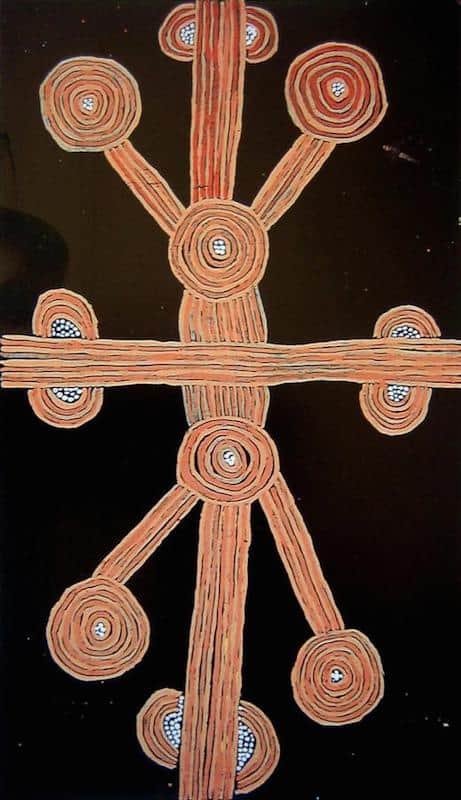
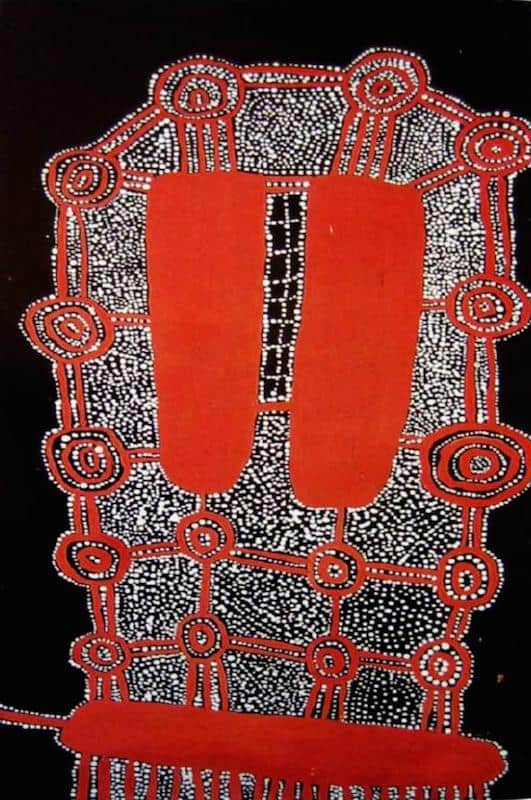
Middle period
Early works aroused strong protest within other Aboriginal communities when first exhibited in Alice Springs in 1974. Other aboriginal groups felt the paintings disclosed to many secrets and much sacred knowledge.
A period of experimentation followed. One solution was for areas to be covered in the characteristic dots of aboriginal art. These dots covered areas and veil sacred elements from the uninitiated.
Uta Uta was influential in helping the painting group break through cultural constraints.
Uta Uta was highly respected and had an exciting and charismatic personality. This along with a bold and dynamic painting style, played a vital role in these developments.
The aesthetic balance and harmony of these works are derived through color and weight rather than by a geometric division of the painted surface.
Despite the popularity of his earliest works, I think Uta Uta flourishes in this middle period.
Yumari
In the early 1980’s, Uta Uta Tjangala completed what was to become one of the most important and revered works of the entire Western Desert art movement. He painted Yumari 1981, his largest and most significant painting.
Yumari reveals the mythical Tingari ancestors traveling across vast stretches of country as they create sites and institute rituals.
Yumari is a rocky outcrop in his home country and the key ceremonial site of the area. Story elements and natural features blend seamlessly into a beautifully balanced geometry of concentric circles and connecting lines that enclose a central, abstracted figure.
Yumari was exhibited at the XVIII Bienal de Sao Paulo in 1983 and is now in the collection of the National Museum of Australia.
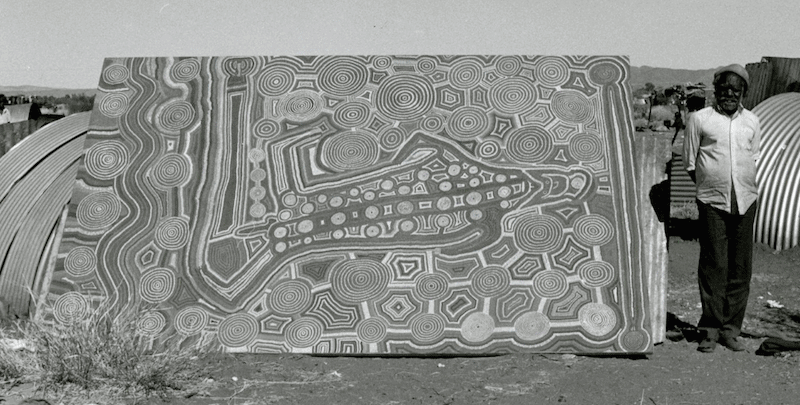
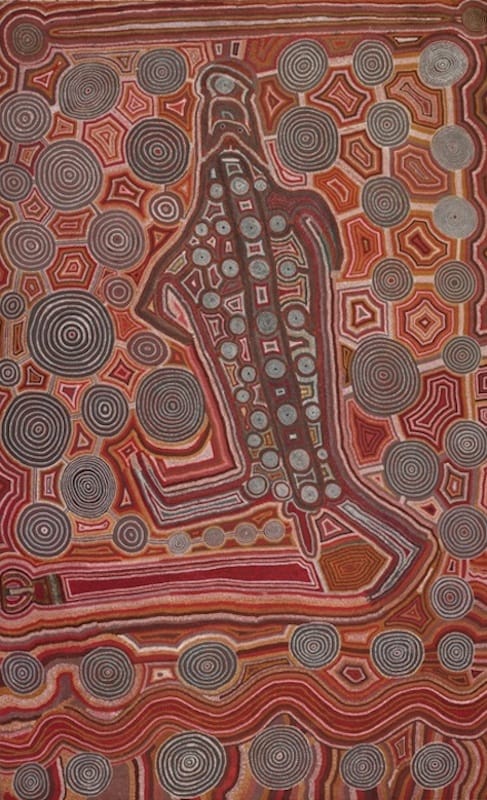
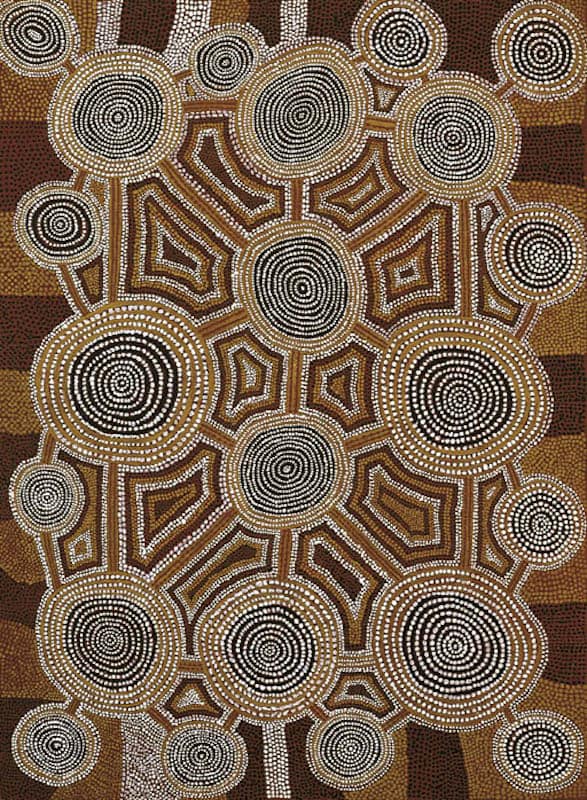
Later Paintings
Uta Uta developed a style that censored the more secret and sacred content in his painting, He added more dot-work as the years went by.
He painted more Tingari sites completely surrounded by neat dots. the sites themselves became less and less detailed.
While painting Yumari, important discussions were taking place at Papunya. Many aboriginals were thinking of moving back to the Pintupi homelands at Kintore. Land rights legislation during the 1970’s returned ownership of the land to its traditional owners. Uta Uta was a strong advocate for resettlement.
Uta Uta was to be amongst the first to resettle in his homelands. He set himself up with his family on a small outstation west of Kintore.
Many of Uta Uta offspring and immediate family became artists. They included his wife Walangkura Napanangka and their five children including Shorty Jackson.
Uta Uta died in 1990 but his art continues as a strong influence on Western Desert art.
Tjangala his skin name varies in spelling and his name can be Uta Uta Tjungala, Uta Uta Djangala or Uta Uta jangala.
Uta Uta Tjangala tribal name also varies so he is sometimes referred to as Wuta Wuta Tjangala, Uata Uata Tjangala, Oata Oata Tjangala or Yuta Yuta Tjangala
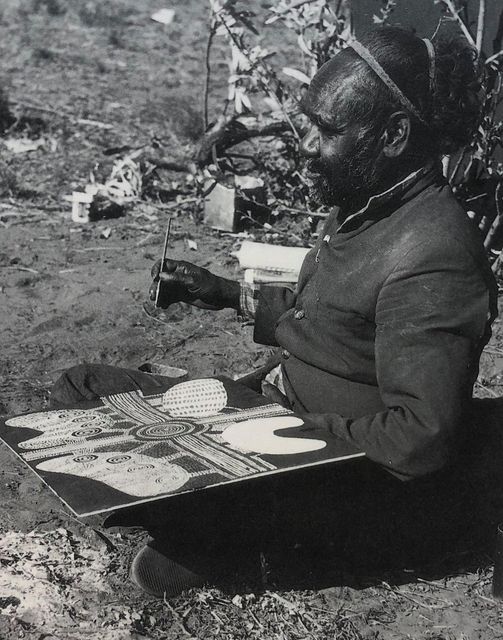
Childrens Story
The central concentric circles represent an old man. The smaller circles are children who are teasing the old man. He is twirling around on his feet, keeping them at bay with a stick. (original description)
Children’s story paintings such as this example by Uta Uta Tjangala were s encouraged by Geoffrey Bardon. During Bardon’s time in Papunya he struggled with the men’s emphatic disclosure of restricted imagery.
Painted 1972, synthetic polymer paint and natural pigments on compressed fibre board
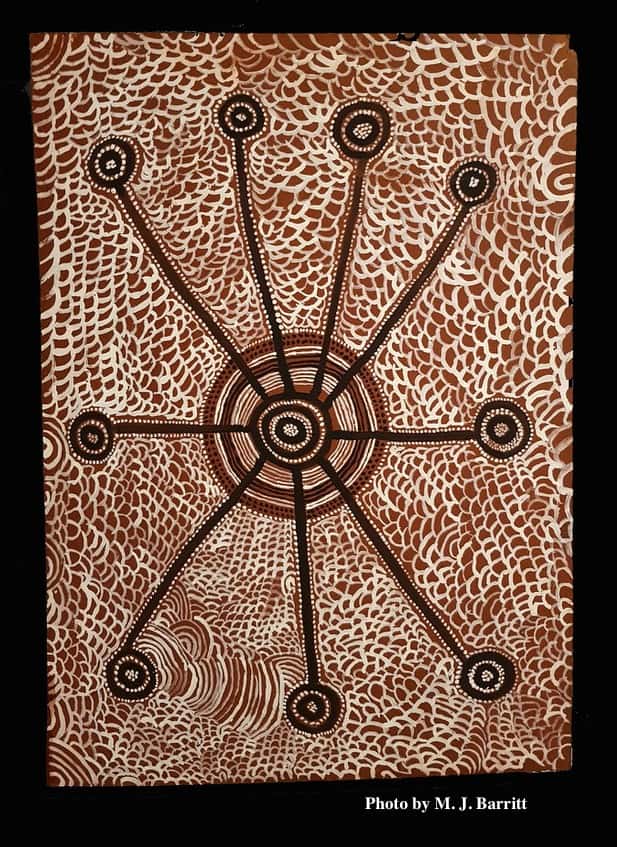
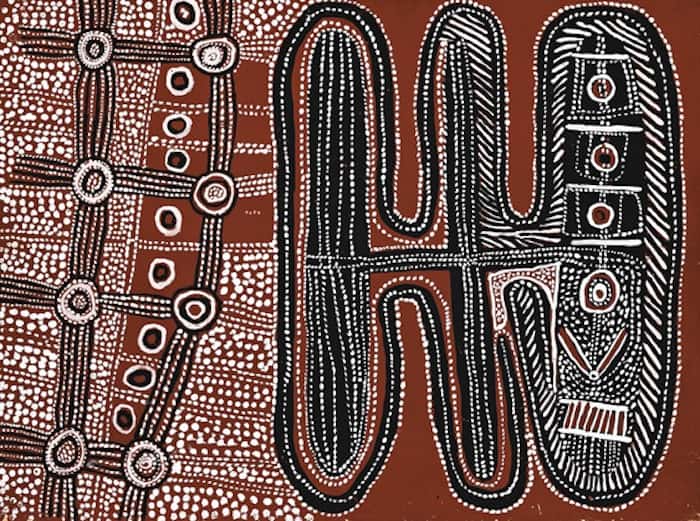
Painted in 1972 using synthetic polymer powder paint on composition board 46cm by 61cm
Old Mens Story
Uta Uta Tjangala was one of the first group of painters who painted ephemeral body and ground designs onto board. At the time he painted this work, two old men who each had only one leg were living in the government settlement of Papunya. , They used crutches to support themselves. It is these two men who are the subject of Uta Uta’s painting (Bardon and Bardon, 2004:387). The composition is in two sections. On the left is a planar map of the country showing campfires as roundels, journey lines between them. Bush foods are shown as a series of circles and scattered dotting. On the right lies a tripartite iconograph referring to the two one-legged men at their camp. This section on the right contains the ceremony designs painted onto their bodies.
The story featuring the two old men is analogous to the principal ancestral beings of the Pintupi. The Tingari, who are usually described as two old men, known generically as the Wati Kutjarra, who traveled across the desert. As these ancestors traveled the gave people the attributes of culture, language, and law. They continue to be the focus of initiation ceremonies today.
Womens Dreaming
This is an old people’s story, where two women indicated by the four dotted shapes at the top of the design represent two pairs of feet. Below them are three concentric circles representing waterholes. To the left is an oval ceremonial object showing body paint on a woman and the concave short lines represent the arms of the women. The other decoration on the ovals is also body paint. Two of the large bottom shapes are arrangements of ceremonial sticks or legs of the ceremonial women.’
The site envisioned is most likely to be Ngurrapalangu, the place where Uta Uta’s mother first felt her son quicken within her. In the distant past, the Kungka Kutjarra danced at Ngurrapalangu, their feet creating the claypan that marks the site. The Kungka Kutajarra later fled north to Wilkinkarra (Lake Mackay), for they feared the advances of Yina, a lascivious old man. Disappointed yet again, Yina trudged westward toward his eventual sexual obliteration at Yumari.
Uta Uta can be compared with Pablo Picasso, who both gravitated toward figuration. Uta Uta is a painter of the body and his expansive gestures emanate from the centrality of ceremonial performance to his identity.
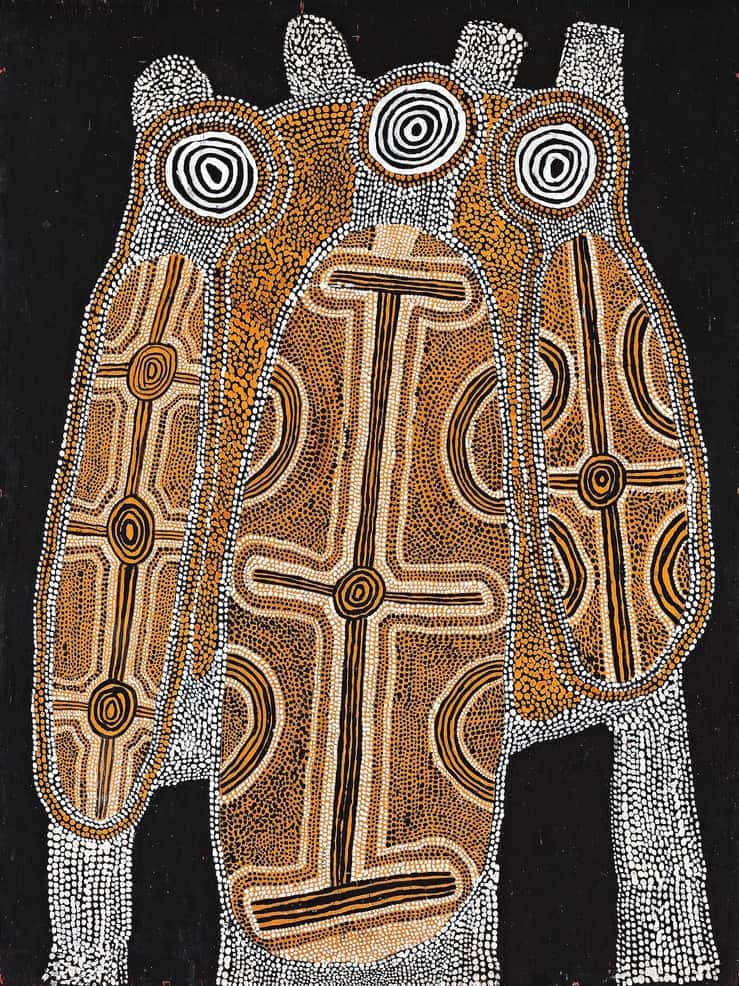
Womans Dreaming Painted 1972 using polymer paint on composition board 60.5 X 45.5 cm
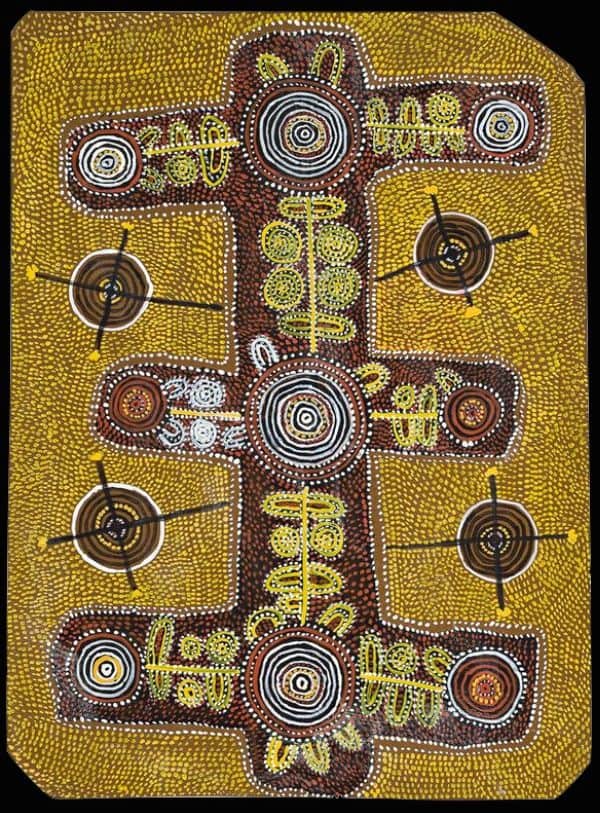
Yumari
Yumari, is a rock hole and an important ancestral site of Uta Uta’s mother’s country. It is a sacred site located between the communities of Walungurru and Kiwirrkura. Uta Uta was the custodian of this site. Yumari is linked to his conception place at Ngurrapalangu through the story of Yina, the ancestral traveling Old Man. Yumari was integral to Tjangala’s personal identity. Yumari, has the literal meaning of ‘mother-in-law place’. It is where the revered ancestor Yina had an illicit liaison with his ancestral mother-in-law. Yina is described as a sorcerer, possessing supernatural powers. Yina’s testicles and penis separated from his body and transformed into features of the landscape. Rocky outcroppings, a rock hole and various markings found within a few hundred meters of this site are believed to be the result of the illicit affair of these mythological beings.
Opposite Yumari painted in 1972 with synthetic polymer on composition board
Pintupi Boy’s Hairpiece Dreaming
Painted 1972 natural earth pigments and synthetic polymer paint on composition board 45.5 x 45.0cm
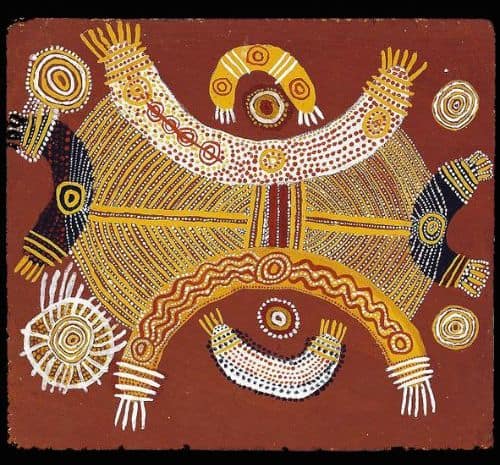
Early Papunya Artworks and Articles
All images in this article are for educational purposes only.
This site may contain copyrighted material the use of which was not specified by the copyright owner.
Uta Uta Tjangala Images
The following images are not the complete known work by this artist but give a good idea of his style and range.

